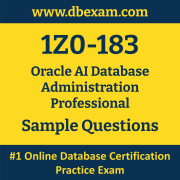01. What differentiates an incremental level 1 cumulative backup from an incremental level 1 differential backup?
a) Cumulative backups capture changes since the last level 0, differential captures since last level 1
b) Cumulative backups capture only changed blocks from the last backup, differential captures entire database
c) Differential backups reset the backup optimization counters, cumulative backups do not
d) There is no difference; both back up changes since the last level 0 backup
02. Which two items must be available to perform a complete recovery of a database using RMAN?
(Choose two)
a) Block change tracking file
b) All archived redo logs
c) Recovery catalog only
d) Latest control file
03. What utility is used with RMAN to perform cross-platform transport of tablespaces between systems with different endian formats?
a) Data Pump
b) Transportable Database
c) RMAN CONVERT TABLESPACE
d) LogMiner
04. Which AWR report type is most suitable for analyzing performance differences between two time periods?
a) AWR Compare Period Report
b) AWR SQL Report
c) ADDM Report
d) ASH Report
05. Why must the RESETLOGS option be used when opening a database after incomplete recovery?
a) It bypasses datafile header checks
b) It preserves the SCN for the next recovery
c) It creates a new incarnation of the database and resets the redo sequence
d) It merges temporary and permanent tablespaces
06. When plugging in a PDB from an earlier release into a 23ai CDB, which action ensures it becomes fully compatible?
a) Running DBMS_PDB.DESCRIBE followed by a metadata-only export
b) Opening the PDB in UPGRADE mode and running catctl.pl scripts
c) Dropping and recreating all application schemas manually
d) Changing COMPATIBLE parameter in init.ora and restarting CDB
07. How does enabling the In-Memory Column Store improve analytic query performance?
a) By storing all tables in row format for faster transactional access
b) By automatically converting redo logs into analytical indexes
c) By eliminating the need for indexes entirely
d) By converting tables to columnar format in memory, accelerating scans and aggregations
08. How does Oracle Database 23ai enforce security isolation between different PDBs within the same CDB?
a) By ensuring each PDB has its own data dictionary and schemas isolated from others
b) By using a separate data dictionary and undo tablespace for each PDB
c) By sharing the SYSTEM and SYSAUX tablespaces across all PDBs
d) By automatically encrypting all cross-PDB links without user configuration
09. When you define a guaranteed restore point, what happens in the background?
a) Oracle starts capturing redo entries in archived logs
b) Oracle enables flashback logs specifically for that restore point
c) Oracle disables normal flashback log purging
d) Oracle schedules automatic RMAN backups
10. Which step is required when creating a Container Database (CDB) using Database Configuration Assistant (DBCA) with the intention to host multiple Pluggable Databases (PDBs)?
a) Disable Oracle Managed Files to manually configure datafiles
b) Select the “Create as Container Database” option and specify the number of PDBs
c) Skip root and seed creation to save space for future PDBs
d) Create separate SYSTEM tablespaces for each seed database
 The Oracle AI Database Administration Professional (1Z0-183) Sample Question Set is designed to help you prepare for the Oracle AI Database Administration Certified Professional certification exam. To become familiar with the actual Oracle Certification exam environment, we suggest you try our Sample Oracle 1Z0-183 Certification Practice Exam.
The Oracle AI Database Administration Professional (1Z0-183) Sample Question Set is designed to help you prepare for the Oracle AI Database Administration Certified Professional certification exam. To become familiar with the actual Oracle Certification exam environment, we suggest you try our Sample Oracle 1Z0-183 Certification Practice Exam.